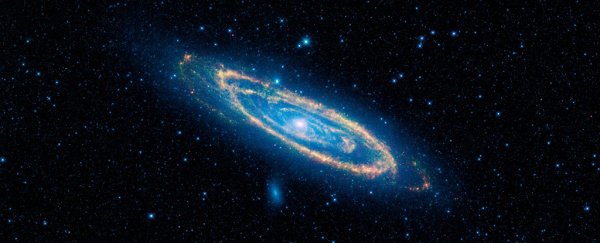There's a mysteriously shaped cluster of stars at the center of the Andromeda Galaxy, around 2.5 million light-years away and neighbor to the Milky Way. It's been causing astronomers to furrow their brows and stroke their chins for decades at this point.
However, new research into how galaxies – and the supermassive black holes at their centers – can collide together may offer an explanation for this cluster. It seems that it might be caused by a gravitational 'kick', something similar to the recoil of a shotgun but on a cosmic scale.
This latest study suggests the kick would be powerful enough to create an elongated mass of millions of stars – technically known as an eccentric nuclear disk – instead of the sort of symmetric star cluster that would typically be in the center of a galaxy like Andromeda.
"When galaxies merge, their supermassive black holes are going to come together and eventually become a single black hole," says astrophysicist Tatsuya Akiba, from the University of Colorado Boulder. "We wanted to know: what are the consequences of that?"
To find out, the team ran computer simulations of supermassive black hole collisions. The resulting force would be enough to pull the orbits of stars near a galactic center into a stretched shape, as seen in Andromeda, according to the calculations.
When galaxies collide, it's thought that their respective black holes spin around each other, picking up speed before eventually slamming together. As you can imagine, that generates a whole lot of energy, released in gravitational wave pulses – we're talking about literal ripples in the fabric of space and time.
While the waves produced by these mergers don't affect the galaxy's stars directly, they can affect their position. Based on the models put together by the researchers, the remaining supermassive black hole can be given a mighty jolt in one direction. If the shove isn't too strong (or too weak), it can drag a bunch of nearby stars with it.
"Those gravitational waves will carry momentum away from the remaining black hole, and you get a recoil, like the recoil of a gun," says Akiba.
 The orbit of stars around a supermassive black hole before (l) and after (r) a gravitational 'kick'. (Steven Burrows/JILA)
The orbit of stars around a supermassive black hole before (l) and after (r) a gravitational 'kick'. (Steven Burrows/JILA)
Some supermassive black holes can travel so fast, they escape their home galaxy altogether. As for those that don't, they can still have the potential to leave star clusters warped in an eccentric nuclear disk, it would appear.
There are thought to be up to 2 trillion galaxies in the Universe, and they don't all follow the same pattern. The researchers say their work could help explain some of the diversity in star clusters that appear outside of Andromeda and the Milky Way.
The next step for this particular type of analysis is to scale it up from the hundreds of stars used in these computer models to millions of stars, and perhaps to apply the same simulation approach to galaxies of different types as well.
"This idea – if you're in orbit around a central object and that object suddenly flies off – can be scaled down to examine lots of different systems," says astrophysicist Ann-Marie Madigan, from the University of Colorado Boulder.
The research has been published in Astrophysical Journal Letters.
